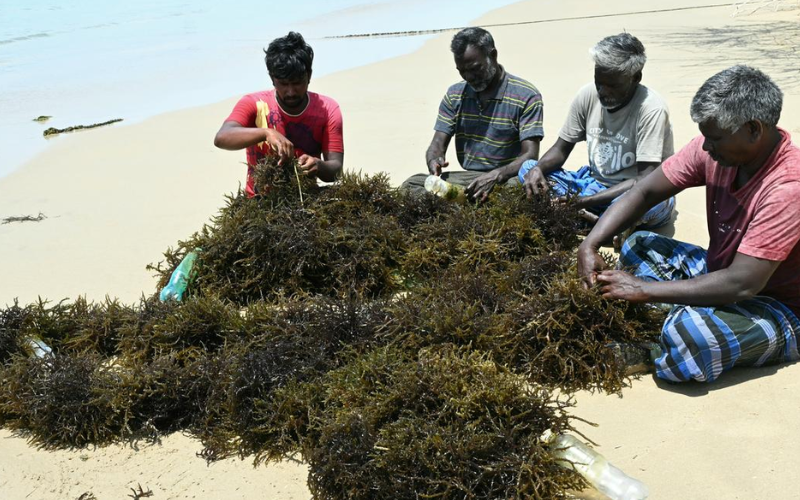In India, seaweed cultivation has been significantly boosted in recent years with focused efforts and investments. The Indian government has been actively promoting seaweed farming through various initiatives including the Pradan Mantri Matsya Samapada Yojana (PMMSY)
Seaweed cultivation, a key component of the blue economy, continues to be a thriving source of livelihood for fishermen in Thoothukudi district, with dried seaweed fetching up to ₹80 to 90 per kilogram. Currently, around five coastal hamlets in the district are highly engaged in its cultivation, producing a significant amount. The marine algae, which is rich in vitamins, minerals such as iodine, calcium, potassium, zinc, is also a great source of omega-3 fatty acids and antioxidants like carotenoids and polyphenols.
This nutrient-rich algae has always been high in demand in East Asian countries and Western countries due to its wide usage in their cuisines. Over a period of time, this has also started playing a significant role as an important compound in many pharmaceutical products, biofertilizers, animal feed, biofuels and skin care products. In India, seaweed cultivation has been significantly boosted in recent years with focused efforts and investments. The Indian government has been actively promoting seaweed farming through various initiatives including the Pradan Mantri Matsya Samapada Yojana (PMMSY).
In Thoothukudi district, around six coastal areas are actively engaged in seaweed cultivation, including Sippikulam, Pattinamarudhur, Vellapatti, Mullakadu and Pullaveli. The main species cultivated in the region is Kappaphycus alvarezii. Jayashankar, a fisherman from Pullaveli who has been involved in this business for the past 18 years said that he has taken this up as a fulltime job, going fishing only during the off season of seaweed cultivation, which is between February and June.
Seaweed is usually cultivated in the region using monoline method, where the seedlings are tied at 8 cm distance in a 15-metre rope, with plastic bottles as floating materials. These are attached to a 100-metre rope, with a maximum of 100 lines, with 30 kg anchors on both sides. In Pullaveli Mr. Jayashankar along with his partners are cultivating the sea weed across up to 1,700 lines and they sold around 10 metric tonnes dried seaweed last year, apart from the wet ones.
He added that currently they are selling both dry and wet seaweeds at ₹80 to 90 and ₹18 per kg respectively.Murugan, another cultivator from Mullakadu East, who has also been in the business for the past 18 years, said, “When I started the business, the dry weed was taken at ₹8 per kg and wet weed was taken at ₹0.85 per kg.”
However, currently the prices have increased, which is economically helpful to the local cultivators. He noted that they had moved from bamboo raft method to monoline method as they are more suitable for the sea condition of Thoothukudi. Mr. Murugan along with other fishermen in the region cultivate the seaweed across 800 lines, fetching over 10 metric tonnes of produce every year.
The major constraints in producing a high-quality seaweed is the environmental conditions such as fluctuations in temperature and salinity leads to “Ice-Ice” disease in the sea weed, which creates white to light grey lesions or spots on seaweed surface, which could be mostly cured by daily monitoring. Grazing by herbivorous fish and natural calamities such as flood affects the seaweed farming, which makes the salinity to less than 10 ppt, causing bleaching to the weed.
Currently the officials from Department of Fisheries and Fishermen Welfare and ICAR-CMFRI, Thoothukudi have been involved in guiding seaweed cultivators in the region. The CMFRI’s project is being funded by National Bank of Agriculture and Rural Development through the project “Environmental Sustainability through Multi-Trophic Aquaculture.”
Speaking on the developing blue economy through seaweed cultivation in Thoothukudi, an official from the fisheries department said that the collected seaweeds are currently being sent to seaweed parks in Pudukottai and Ramanathapuram. The official added, “Though the sea weed cultivation has seen significant growth in recent years, there are still some constraints in marketing, seed supply and unprecedented environmental factors.”
News Courtesy: Thehindu

